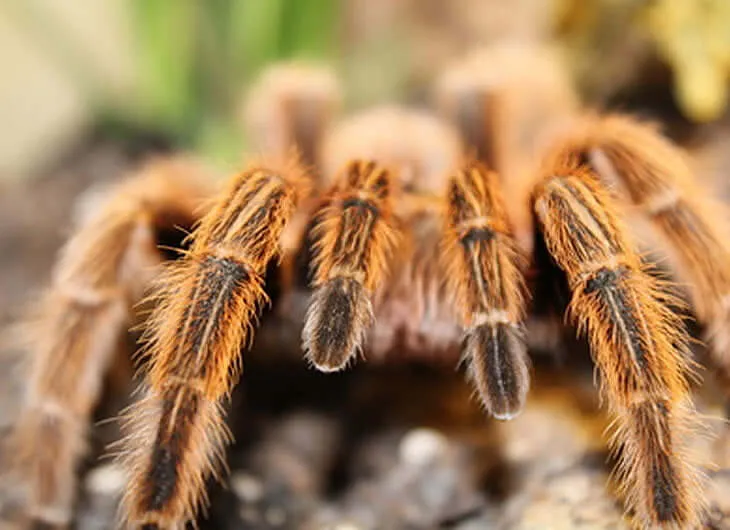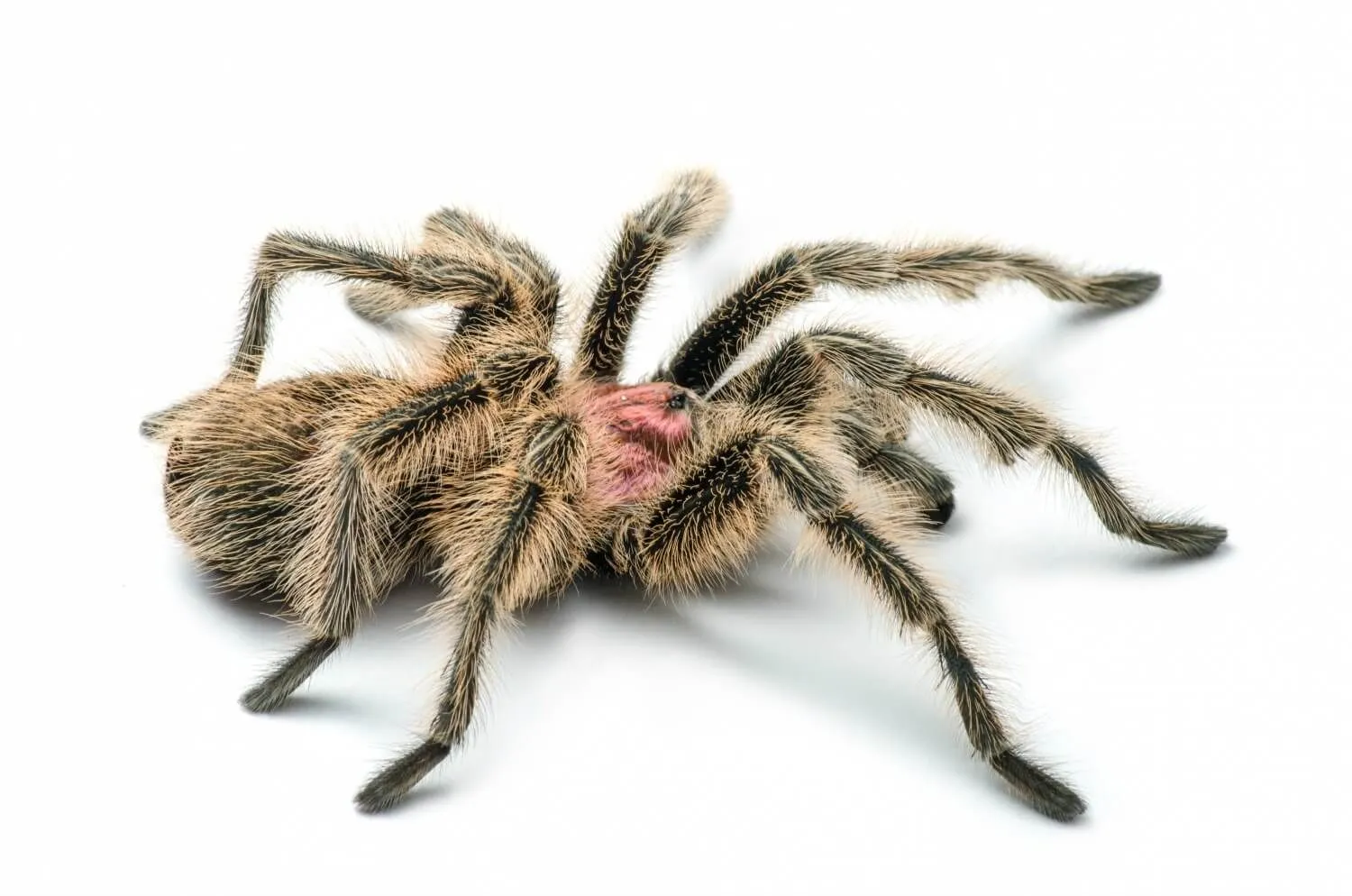The Chilean Rose Tarantula, also known as the Rose Hair Tarantula, is a popular pet due to its docile nature, relatively low maintenance needs, and beautiful appearance. This comprehensive care sheet provides everything you need to know to provide a happy and healthy life for your Chilean Rose Tarantula. From choosing your tarantula to understanding its health, this guide covers all the essential aspects of care.
Choosing Your Chilean Rose Tarantula
Selecting a healthy Chilean Rose Tarantula is the first step toward successful pet ownership. Consider the spider’s activity level, physical condition, and overall demeanor. Look for a tarantula that is alert, moving around its enclosure, and has a plump abdomen. Avoid spiders that appear lethargic, have a shrunken abdomen (indicating dehydration or lack of food), or show signs of parasites or injuries. A reputable breeder or pet store will be able to provide you with a healthy specimen and answer any initial questions you might have. When selecting a Chilean Rose Tarantula, it is important to observe its behavior and physical attributes to ensure you’re bringing home a healthy pet. A vibrant and active tarantula is a sign of good health, and a proactive approach will enhance your pet ownership experience.
Where to Buy Your Tarantula
You can purchase a Chilean Rose Tarantula from several sources. Reputable reptile and exotic pet stores are a good option, as they often have experienced staff who can provide care advice. Online breeders and sellers also offer these tarantulas, but it is crucial to research the seller thoroughly and read reviews before making a purchase. Local reptile shows are another venue where you can find healthy tarantulas and speak directly with breeders. Always prioritize sellers who prioritize the health and well-being of their animals. When buying online, ensure the seller provides a live arrival guarantee and ships the tarantula securely in an appropriate container with sufficient insulation and ventilation. Consider that buying from a breeder helps support ethical practices and ensures the tarantula has received proper care from the start. Local stores and reptile shows provide opportunities to examine the spider before purchase and obtain real-time advice.
Checking for a Healthy Tarantula

When assessing a Chilean Rose Tarantula’s health, examine several key features. The tarantula should have a full abdomen, indicating it is well-fed and hydrated. The legs should be intact and move without difficulty. Check for any signs of mites, parasites, or injuries. The fangs should be in good condition. The tarantula’s overall appearance should be vibrant, not dull or lethargic. Also observe the tarantula’s behavior; a healthy tarantula will be alert and responsive to its environment. Avoid tarantulas with any obvious deformities, missing legs (unless a recent molt), or signs of disease. Before bringing a Chilean Rose Tarantula home, take your time to check the tarantula. This detailed inspection will help ensure that you adopt a healthy pet and avoid problems later on. Additionally, inquiring about the spider’s feeding habits and molting history can provide insights into its health and well-being.
Housing Your Chilean Rose Tarantula
Providing the right enclosure is critical to your Chilean Rose Tarantula’s well-being. The enclosure should be spacious enough for the tarantula to move around, but not so large that it feels exposed and stressed. It should also be secure to prevent escapes and have proper ventilation to maintain air quality. A well-designed enclosure mimics the tarantula’s natural habitat and provides a comfortable and secure living space. Consider factors such as the size of the tarantula, its molting habits, and your ability to clean and maintain the enclosure when selecting the appropriate setup. It’s important to ensure the enclosure is escape-proof, which will prevent the tarantula from getting loose. A well-designed enclosure is a fundamental aspect of responsible tarantula care and will provide your pet with a secure and comfortable environment to thrive.
Enclosure Size & Type
For an adult Chilean Rose Tarantula, a 10-gallon tank is often adequate, though a 15-20 gallon tank can provide additional space for enrichment. The enclosure should be wider than it is tall, as these tarantulas are terrestrial and do not climb extensively. Glass or acrylic tanks are both suitable; glass is generally more scratch-resistant and easier to clean, while acrylic is lighter and provides better insulation. The enclosure must have a secure lid to prevent the tarantula from escaping. Ensure the lid has ventilation holes to allow for airflow. The enclosure’s dimensions should allow the tarantula to move freely without feeling cramped, and the materials should be non-toxic and easy to clean. Selecting an appropriately sized and designed enclosure is crucial for the tarantula’s comfort and safety. Always make sure the enclosure’s design is practical for both the tarantula’s needs and your maintenance routine, which will promote a healthy and stress-free environment.
Substrate and Decoration

The substrate is the bedding material in the enclosure. A good substrate for a Chilean Rose Tarantula retains moisture, allows the tarantula to burrow, and is easy to clean. A mixture of peat moss, coconut fiber (coir), and a small amount of vermiculite is often recommended. Avoid using sand, gravel, or wood shavings, as these can be harmful to the tarantula. The substrate should be deep enough for the tarantula to burrow if it desires. Decorations can enrich the enclosure and provide hiding places. Cork bark, artificial plants, and sturdy branches can be added to the enclosure to provide enrichment and a sense of security. Make sure decorations are secure and do not pose a risk of injury to the tarantula. The combination of a suitable substrate and carefully chosen decorations creates a naturalistic and stimulating environment. This approach enhances the tarantula’s well-being by allowing it to engage in natural behaviors and providing a comfortable living space.
Temperature and Humidity
Chilean Rose Tarantulas thrive in a temperature range of 70-80°F (21-27°C). While supplemental heating is not usually necessary, a low-wattage heat lamp or a heat mat placed on the side of the enclosure can be used if the room temperature is consistently below this range. Avoid placing the heat source directly under the enclosure, as this can overheat the substrate. The humidity level should be maintained at around 60-70%. This can be achieved by lightly misting the enclosure with dechlorinated water once or twice a week or by providing a water dish. Monitor the humidity with a hygrometer and adjust your misting schedule accordingly. Proper temperature and humidity levels are crucial for the tarantula’s health, molting process, and overall well-being. Consistent monitoring and adjustments will ensure the environment is ideal for your pet.
Feeding Your Chilean Rose Tarantula
Feeding is a critical aspect of caring for a Chilean Rose Tarantula. The tarantula’s diet should consist of insects, and the frequency of feeding depends on its age and the size of the prey. Always provide fresh water, and be mindful of uneaten food in the enclosure. A well-nourished tarantula is healthier, more active, and more likely to thrive. The following guidelines will help you determine the appropriate diet and feeding schedule for your Chilean Rose Tarantula, which can lead to successful pet ownership and a healthy tarantula. The right feeding habits will support its growth, energy levels, and overall vitality.
What to Feed Your Tarantula

The primary food source for a Chilean Rose Tarantula is insects. Suitable prey items include crickets, mealworms, dubia roaches, and occasionally, waxworms (as a treat). The insects should be appropriately sized for the tarantula; as a general rule, the prey should be no larger than the tarantula’s abdomen. It’s also essential to gut-load the insects before feeding them to your tarantula. This means feeding the insects a nutritious diet (such as commercially available cricket food or fresh vegetables and fruits) to ensure they are packed with vitamins and minerals, which your tarantula will then consume. Avoid feeding wild-caught insects, as they may carry parasites or pesticides. Supplementing the diet with commercially available tarantula vitamins can also be beneficial. Selecting the right prey and ensuring it is nutritious are key elements in providing a balanced diet, which enhances the tarantula’s health and vitality.
Feeding Frequency
The feeding frequency for a Chilean Rose Tarantula depends on its age and size. Spiderlings (young tarantulas) should be fed 2-3 times per week. Juvenile tarantulas can be fed once or twice a week, while adult tarantulas often only need to be fed once every 1-2 weeks. Observe your tarantula’s abdomen; if it appears full and plump, it doesn’t need to be fed as frequently. Remove any uneaten prey within 24 hours, as they can stress the tarantula and potentially harm it. Always provide fresh water. Adjust the feeding schedule based on the tarantula’s appetite, molting cycle, and overall health. By observing the tarantula’s behavior and appearance, you can fine-tune the feeding schedule to ensure it receives the appropriate nutrition for its growth and well-being. Regularly monitoring your pet’s needs and adapting your approach is fundamental to proper care.
Watering Your Tarantula
Providing fresh water is as essential as feeding. A shallow water dish should always be available in the enclosure. The dish should be shallow enough to prevent the tarantula from drowning. Use dechlorinated water or bottled spring water. Refill the water dish as needed, typically every other day. In addition to a water dish, you can mist the enclosure lightly with dechlorinated water once or twice a week to maintain humidity. Avoid over-misting, as this can lead to mold growth. Regularly monitor the water dish and the humidity levels in the enclosure to ensure that your tarantula stays properly hydrated and in a healthy environment. Water is critical for the tarantula’s metabolism, molting process, and overall health. Providing a clean water source, along with maintaining the right humidity, helps the tarantula thrive and stay healthy.
Handling and Safety

While Chilean Rose Tarantulas are known for their docile nature, it is essential to handle them with care and respect. Understand the potential risks involved, and always prioritize the tarantula’s safety and well-being. Handling should be limited, and done only when necessary. This section provides guidelines for safe handling, recognizing signs of stress, and understanding the importance of caution when interacting with your tarantula. Maintaining a cautious approach will protect both the tarantula and the handler. When handling a tarantula, the focus should be on the tarantula’s comfort and security. With the right handling approach, you can minimize any risks.
Handling Guidelines
Handling a Chilean Rose Tarantula should be kept to a minimum, as it can be stressful for the tarantula. If you must handle your tarantula, do so gently and slowly. Wash your hands thoroughly before and after handling to remove any potential contaminants. Never pick up a tarantula from a height, as a fall can be fatal. Instead, encourage it to walk onto your hand. Keep your movements slow and deliberate, and avoid sudden motions. Always supervise children when they are near the tarantula’s enclosure. Be prepared to react quickly if the tarantula starts to act defensively, such as raising its front legs. Although Chilean Rose Tarantulas are generally not aggressive, they can bite if they feel threatened, and their urticating hairs can cause skin irritation. By following these guidelines, you can minimize the risks associated with handling and ensure the safety of both yourself and your pet.
Recognizing a Stressed Tarantula
It is crucial to recognize signs of stress in your Chilean Rose Tarantula. A stressed tarantula may exhibit several behaviors. Defensive postures include raising its front legs, displaying its fangs, or flicking urticating hairs from its abdomen. The tarantula may also become extremely reclusive, hiding in its burrow or not moving at all. Other signs of stress include loss of appetite, excessive twitching, and a noticeable change in color. If you observe any of these behaviors, immediately cease handling or disturbing the tarantula. Provide a safe and secure environment, and allow it to settle down. Minimize any potential stressors, such as loud noises, vibrations, or excessive handling. If the stress persists, review your care practices and ensure that all environmental conditions are optimal. Recognizing and addressing stress promptly is crucial to ensure your tarantula’s health and well-being. By paying close attention to your tarantula’s behavior, you can identify and alleviate potential problems early on.
Health and Common Issues

Chilean Rose Tarantulas are generally hardy, but they can be susceptible to certain health issues. Understanding the molting process, recognizing common health problems, and taking preventative measures are essential to ensuring your tarantula’s longevity. This section provides insights into the molting process, which is a natural and vital event in the tarantula’s life cycle, and some common health problems to watch out for. By being informed and proactive, you can help keep your tarantula healthy and thriving. Proper care, environmental conditions, and regular monitoring are key to preventing and addressing health issues, providing your pet with the best possible care.
Moulting Process
Moulting is a natural process where tarantulas shed their exoskeleton to grow. During this process, the tarantula will typically stop eating, and the abdomen may darken. The tarantula may also lie on its back. Do not disturb the tarantula during the moulting process. Provide a humid environment and avoid handling. The entire process can take several hours or even days. After moulting, the tarantula will be vulnerable and have soft new exoskeletons. Do not feed the tarantula until its fangs have hardened, which can take a week or two. Always provide fresh water, and ensure the tarantula has a safe and secure environment to complete the molting process. Proper care and attention during molting are crucial for the tarantula’s health and growth.
Common Health Problems
Several health issues can affect Chilean Rose Tarantulas. Mites are tiny parasites that can infest the tarantula. Signs of mites include small, moving specks on the tarantula’s body, especially around the legs and abdomen. To treat mites, quarantine the tarantula and clean the enclosure thoroughly. Other issues include fungal infections, which can occur if the enclosure is too humid or poorly ventilated. Signs of fungal infections include discolored patches on the tarantula’s body. Provide good ventilation and maintain proper humidity levels. Dehydration is another concern, which can result from a lack of water or low humidity. Ensure a constant water supply and monitor the humidity. Injuries can also occur, particularly during handling. Always handle the tarantula gently and with care. By being aware of potential health problems and taking appropriate preventive measures, you can keep your tarantula healthy and thriving.
Lifespan and Breeding

Understanding the lifespan of a Chilean Rose Tarantula and its breeding behaviors is essential for responsible pet ownership. This section provides insights into the average lifespan of these tarantulas and the factors that can influence it. In addition, it explores the basics of breeding Chilean Rose Tarantulas, which is more suitable for experienced keepers. By being informed, you can provide the best possible care for your tarantula and have a deeper understanding of its life cycle. Considering their potential longevity, adopting a tarantula is a commitment to care for your pet throughout its entire life.
Understanding Tarantula Lifespan
The lifespan of a Chilean Rose Tarantula varies depending on its sex. Female tarantulas typically live longer than males, with females often living for 10-20 years or even longer. Male tarantulas, on the other hand, usually have a lifespan of 5-10 years. The lifespan can be influenced by factors such as diet, environmental conditions, and overall health. Providing a proper diet, maintaining appropriate temperature and humidity levels, and preventing health problems are crucial for maximizing your tarantula’s lifespan. While tarantulas can live for many years, proper care is essential to ensure a long and healthy life. Lifespan is an essential consideration when getting a Chilean Rose Tarantula. Taking into account the potential longevity and making informed choices regarding care will lead to greater satisfaction.
Breeding Chilean Rose Tarantulas
Breeding Chilean Rose Tarantulas is a complex process and is generally recommended for experienced keepers. Breeding involves introducing a mature male tarantula to a mature female tarantula. The female may be receptive, or she may attack the male, so careful observation is required. If successful, the female will lay an egg sac containing hundreds of eggs. The egg sac must be carefully maintained at the correct temperature and humidity to hatch. The spiderlings require specialized care. Breeding tarantulas is a significant undertaking that requires knowledge, time, and resources. Proper preparation is essential to increase the chances of a successful breeding event and provide a healthy environment for the spiderlings. Breeding is a complex aspect of tarantula keeping. It involves various considerations and is usually recommended for experienced keepers who possess a solid understanding of the species and its requirements.
In conclusion, caring for a Chilean Rose Tarantula is a rewarding experience. By providing the right environment, diet, and handling practices, you can ensure that your pet lives a long and healthy life. Regularly monitor your tarantula’s health, behavior, and environment to catch any potential issues early. Remember that patience, observation, and a commitment to learning are key to successful tarantula ownership. With the right care and attention, your Chilean Rose Tarantula will become a fascinating and cherished member of your family. This comprehensive care guide is your ultimate resource for providing excellent care for your Chilean Rose Tarantula and enjoying all the benefits of this unique and captivating pet.
